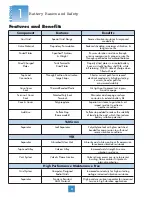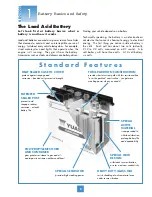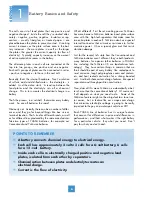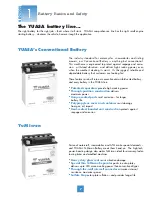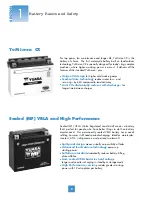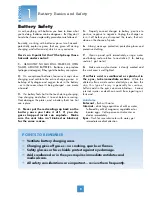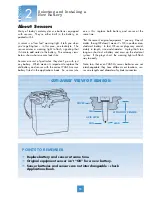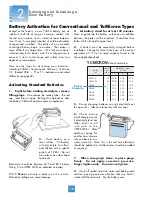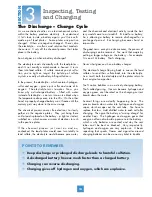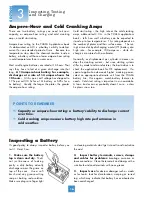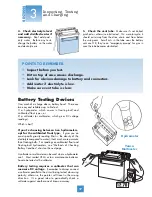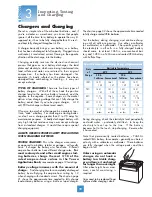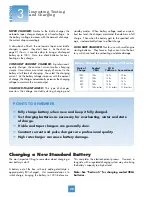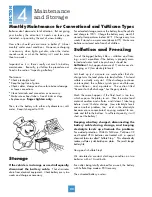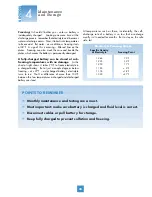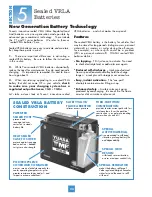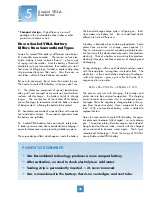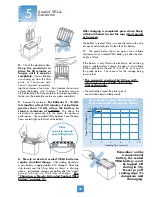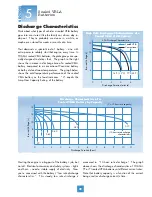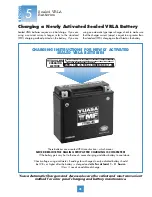
Ampere-Hour and Cold Cranking Amps
There are two battery ratings you need to know:
capacity, or ampere-hour rating, and cold cranking
amps, or cold start rating.
Ampere-hour rating (in the YUASA Applications book
it’s abbreviated as AH) is a battery’s ability to deliver
current for an extended period of time. Because low
temperatures slow down the chemical reaction inside a
battery, a battery will have a lower ampere-hour rating
in cold temperatures than in warm ones.
Most small engine batteries are rated at 10 hours. That
says they have to last at a given discharge rate that
long.
A 14 ampere-hour battery, for example,
discharges at a rate of 1.4 ampere-hours for
10 hours.
At this point, cell voltage has dropped to
1.75v per cell (10.5v for a 12v battery, or 5.25v for a
6v battery). Usually, the larger the plates, the greater
the ampere-hour rating.
Inspecting a Battery
It’s good policy to always inspect a battery before you
test it. Here’s how:
1. Make sure the battery
top is clean and dry.
That’s
not just because of looking
pretty: a dirty battery actually
discharges across the grime on
top of the case. Use a soft
brush and any grease-cutting
soap or baking soda solution.
Make sure plugs are finger tight
so cleaning materials don’t get into cells and neutralize
the acid.
2. Inspect battery terminals, screws, clamps
and cables for problems:
breakage, corrosion or
loose connections. Clean the terminals and clamps with a
wire brush and coat terminals with no ox grease.
3. Inspect case
for obvious damages such as cracks
or for leaks; look for discoloration, warping or raised
top, which may indicate that battery has overheated or
been overcharged.
POINTS TO REMEMBER
❐
Capacity or ampere-hour rating: a battery’s ability to discharge current
over time.
❐
Cold cranking amps measure battery high rate performance in
cold weather.
16
Cold start rating – the high rate or the cold cranking
amps, abbreviated C.C.A. in the YUASA applications
book – tells how well a battery can be expected to
stand up to low temperatures. This rating depends on
the number of plates and their surface area. The rat-
ing’s arrived at by discharging a cold (0°F) battery at a
high rate – for example, 150 amperes – while dis-
charge is monitored with a voltmeter.
Generally, as displacement per cylinder increases, so
does the cranking current – but since starting systems
differ by model and manufacturer, the best advice is to
check the application book for OE replacement. If a
special application demands higher cranking power,
select an appropriate alternate unit from the YUASA
battery line. Once again, match battery features to
needs. Cold start rating is important in a snowmobile.
A lawn tractor owner probably doesn’t care... unless
he plows snow, too.
3
SECTION
Inspecting, Testing
and Charging
Summary of Contents for SmartShot Automatic 12V 1.5 Amp 5 Stage
Page 1: ......



